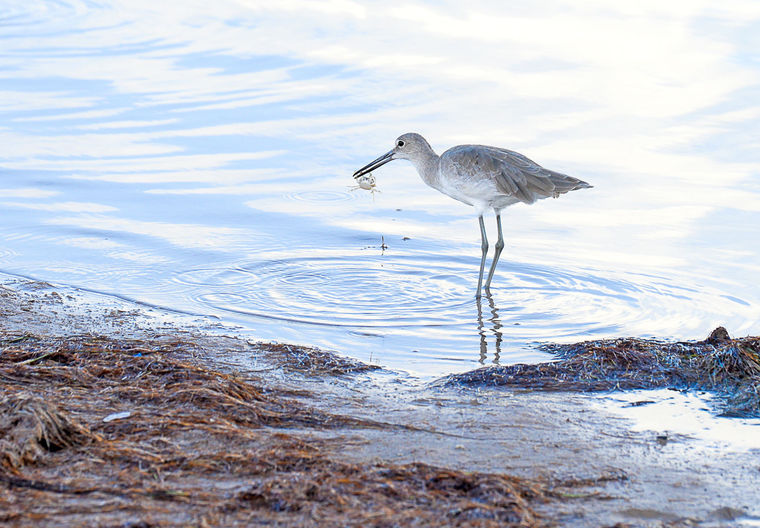A major land acquisition by The Nature Conservancy represents the final piece of the puzzle in the restoration of the sprawling Bahia Grande wetland between Brownsville and the Laguna Madre.
TNC just closed on the purchase of 1,800 acres on the wetland’s north side, according to Boyd Blihovde, manager of the Laguna Atascosa National Wildlife Refuge, which in 2000 acquired the 21,700-acre “Bahia Grande Unit.” Both are managed by the U.S. Fish and Wildlife Service.
It sort of completes the acquisition for the Bahia Grande wetland,” he said. “The estuary system that is called Bahia Grande, we always were trying to get the whole wetland system, and to the north there was a big chunk that was left out.”
The Bahia Grande was a thriving wetland home to a number of species of fish and wildlife until the tidal flow between it and the Laguna Madre was cut off, starting in the 1930s with construction of the Brownsville Ship Channel and continuing in the 1950s when S.H. 100 was built.
Rancher and philanthropist Frank Yturria, whose family has placed 10,000 acres into wildlife conservation easements to protect the ocelot and aplomado falcon, and whose contributions were instrumental in the Bahia Grande’s resurrection, said he’s old enough to remember before the wetland dried up.
“When I was a kid my mother and father and friends, we’d go to the Bahia Grande to go crabbing.” he said. “There were so many crabs you could just go along the shoreline and scoop them up. You didn’t even need to put out bait.”
Yturria watched the Bahia Grande dry up until it was a desert, which is how it remained for 70 years, choking Laguna Madre communities with dust, until mounting calls to return the water to the Bahia Grande led to concerted action.
Twenty years ago, The Conservation Fund bought the original land tracts from Yturria that got the ball rolling on restoration. In 2005, a 50-foot-wide pilot channel was dug between the ship channel and the Bahia Grande to let the water back in. In 2007, two interior channels were cut connecting the Bahia Grande Basin, the wetland’s main body of water, with two smaller interior basins, the Laguna Larga and Little Laguna Madre, which restored tidal flow throughout the whole system.
Andy Jones, director of TCF’s Texas office, said it’s gratifying to see how far the Bahia Grande project has come.
“It’s absolutely satisfying to see it, and the rest of work we’ve been accomplishing, and to see all the restoration work,” he said. “The lakes were dry there forever. Fortunately now there’s flow. Now its wildlife haven full of fish and all the birds.”
Blihovde said Fish and Wildlife will work with The Nature Conservancy on fixing up the newly purchased 1,800 acres.
“We will have the ability, partnering with TNC, to conduct restoration activities on that northern section, including removing old levees and dikes, old oil platforms and things like that,” he said.
Meanwhile, the existing pilot channel is already silting in and needs to be cleaned out, widened and stabilized to provide an adequate flow of water, Blihovde said. General Land Office funding that was available dried up. Now the project partners are beating the bushes for other sources of funding, such as money from the BP oil spill settlement, Blihovde said.
“It’s a high priority for many partners down in the Valley,” he said. “There’s a lot of support for it. I’m sure it will be funded. It’s just a matter of when.”
One thing is clear: The Bahia Grande is coming back to life.
“It is well on its way back,” Blihovde said. “Not only is it not a dust bowl, but it is an important estuary for a number of species, including — believe it or not — for sea turtles. The green sea turtles go in and out of that pilot channel and the Bahia Grande and stay for varying lengths of time, because there’s sea grasses that are coming back in the interior of that wetland.”
The wetland also supports shrimp and other invertebrates that redfish, trout, flounder and other fish species depend on, he said.
“It’s a real important nursery for fisheries, and I think it will continue to be really important, and that in turn will make it a very sought after place for folks who want to go fishing and kayaking and other activities,” Blihovde said. “Fish and Wildlife is currently working on a visitors services plan that will take some to complete, but we’re hoping to open Bahia Grande to the public in stages.”
Jeff Francell, director of land protection for TNC’s Texas chapter, said that in addition to the 1,800 acres, TNC purchased 321 acres as a connector between the Laguna Atascosa refuge and the Bahia Grande. RESTORE Act funds from the BP oil disaster paid for all of it, three parcels in all at a cost of $5 million, he said. The land was purchased from descendents of the Garcia family.
“Protecting the land around the Bahia has been a longstanding conservation priority in Texas we wouldn’t have had the funding to do it without the RESTORE funds,” Francell said. “The (oil spill) was a terrible accident, but we have been able to do some good work with it in Texas. The restoration piece of the entire Laguna Madre system benefits the Gulf of Mexico. That’s the justification.”
TNC said the Bahia Grande is among the highest-priority and most biologically rich conservation areas in the state. The wetland supports about 1,200 plant species, more than 530 species of birds, more than 300 North American butterfly species, and 17 threatened of endangered species, according to TNC.
“We’re not done,” Francell said. “We’re still going to be working hard in trying to come up with funding to continue with acquisitions from willing sellers. Hopefully it’s a significant wildlife area and recreational resource for the Valley and its visitors for all time.”
By STEVE CLARK Staff Report





